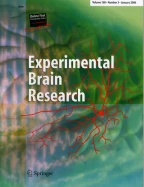Abstract
When the eyes and arm are involved in a tracking task, the characteristics of each system differ from those observed when they act alone: smooth pursuit (SP) latency decreases from 130 ms in external target tracking tasks to 0 ms in self-moved target tracking tasks. Two models have been proposed to explain this coordination. The common command model suggests that the same command be addressed to the two sensorimotor systems, which are otherwise organized in parallel, while the coordination control model proposes that coordination is due to a mutual exchange of information between the motor systems. In both cases, the interaction should take into account the dynamic differences between the two systems. However, the nature of the adaptation depends on the model. During self-moved target tracking a perturbation was applied to the arm through the use of an electromagnetic brake. A randomized perturbation of the arm increased the arm motor reaction time without affecting SP. In contrast, a constant perturbation produced an adaptation of the coordination control characterized by a decrease in arm latency and an increase in SP latency relative to motor command. This brought the arm-to-SP latency back to 0 ms. These results support the coordination control model.
Similar content being viewed by others
Author information
Authors and Affiliations
Additional information
Received: 24 November 1997 / Accepted: 1 July 1998
Rights and permissions
About this article
Cite this article
Scarchilli, K., Vercher, JL. The oculomanual coordination control center takes into account the mechanical properties of the arm. Exp Brain Res 124, 42–52 (1999). https://doi.org/10.1007/s002210050598
Issue Date:
DOI: https://doi.org/10.1007/s002210050598
